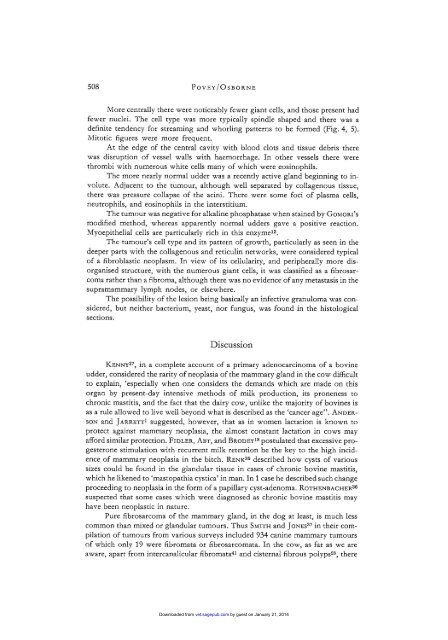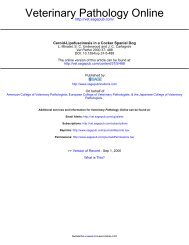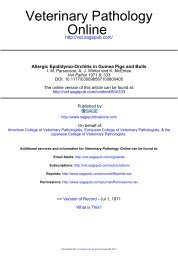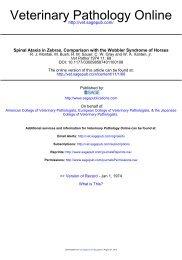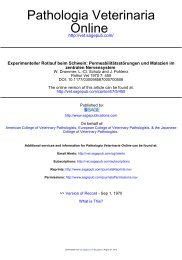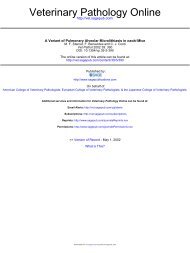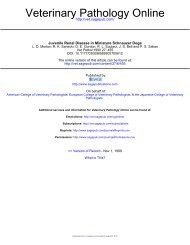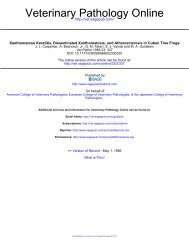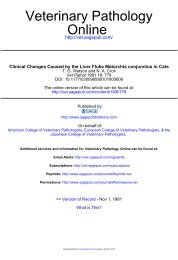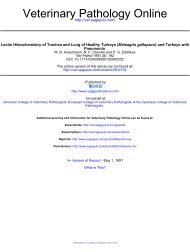Mammary Gland Neoplasia in the Cow - Veterinary Pathology
Mammary Gland Neoplasia in the Cow - Veterinary Pathology
Mammary Gland Neoplasia in the Cow - Veterinary Pathology
Create successful ePaper yourself
Turn your PDF publications into a flip-book with our unique Google optimized e-Paper software.
508 POVEY/OSBORNE<br />
More centrally <strong>the</strong>re were noticeably fewer giant cells, and those present had<br />
fewer nuclei. The cell type was more typically sp<strong>in</strong>dle shaped and <strong>the</strong>re was a<br />
def<strong>in</strong>ite tendency for stream<strong>in</strong>g and whorl<strong>in</strong>g patterns to be formed (Fig. 4, 5).<br />
Mitotic figures were more frequent.<br />
At <strong>the</strong> edge of <strong>the</strong> central cavity with blood clots and tissue debris <strong>the</strong>re<br />
was disruption of vessel walls with haemorrhage. In o<strong>the</strong>r vessels <strong>the</strong>re were<br />
thrombi with numerous white cells many of which were eos<strong>in</strong>ophils.<br />
The more nearly normal udder was a recently active gland beg<strong>in</strong>n<strong>in</strong>g to <strong>in</strong>volute.<br />
Adjacent to <strong>the</strong> tumour, although well separated by collagenous tissue,<br />
<strong>the</strong>re was pressure collapse of <strong>the</strong> ac<strong>in</strong>i. There were some foci of plasma cells,<br />
neutrophils, and eos<strong>in</strong>ophils <strong>in</strong> <strong>the</strong> <strong>in</strong>terstitium.<br />
The tumour was negative for alkal<strong>in</strong>e phosphatase when sta<strong>in</strong>ed by GOMORI’S<br />
modified method, whereas apparently normal udders gave a positive reaction.<br />
Myoepi<strong>the</strong>lial cells are particularly rich <strong>in</strong> this enzyme13.<br />
The tumour’s cell type and its pattern of growth, particularly as seen <strong>in</strong> <strong>the</strong><br />
deeper parts with <strong>the</strong> collagenous and reticul<strong>in</strong> networks, were considered typical<br />
of a fibroblastic neoplasm. In view of its cellularity, and peripherally more disorganised<br />
structure, with <strong>the</strong> numerous giant cells, it was classified as a fibrosarcoma<br />
ra<strong>the</strong>r than a fibroma, although <strong>the</strong>re was no evidence of any metastasis <strong>in</strong> <strong>the</strong><br />
supramammary lymph nodes, or elsewhere.<br />
The possibility of <strong>the</strong> lesion be<strong>in</strong>g basically an <strong>in</strong>fective granuloma was considered,<br />
but nei<strong>the</strong>r bacterium, yeast, nor fungus, was found <strong>in</strong> <strong>the</strong> histological<br />
sections.<br />
Discussion<br />
KENNY27, <strong>in</strong> a complete account of a primary adenocarc<strong>in</strong>oma of a bov<strong>in</strong>e<br />
udder, considered <strong>the</strong> rarity of neoplasia of <strong>the</strong> mammary gland <strong>in</strong> <strong>the</strong> cow difficult<br />
to expla<strong>in</strong>, ‘especially when one considers <strong>the</strong> demands which are made on this<br />
organ by present-day <strong>in</strong>tensive methods of milk production, its proneness to<br />
chronic mastitis, and <strong>the</strong> fact that <strong>the</strong> dairy cow, unlike <strong>the</strong> majority of bov<strong>in</strong>es is<br />
as a rule allowed to live well beyond what is described as <strong>the</strong> ‘cancer age”. ANDER-<br />
SON and JARRETT~ suggested, however, that as <strong>in</strong> women lactation is known to<br />
protect aga<strong>in</strong>st mammary neoplasia, <strong>the</strong> almost constant lactation <strong>in</strong> cows may<br />
afford similar protection. FIDLER, ABT, and BRODEY’S postulated that excessive progesterone<br />
stimulation with recurrent milk retention be <strong>the</strong> key to <strong>the</strong> high <strong>in</strong>cidence<br />
of mammary neoplasia <strong>in</strong> <strong>the</strong> bitch. RENK~~ described how cysts of various<br />
sizes could be found <strong>in</strong> <strong>the</strong> glandular tissue <strong>in</strong> cases of chronic bov<strong>in</strong>e mastitis,<br />
which he likened to ‘mastopathia cystica’ <strong>in</strong> man. In 1 case he described such change<br />
proceed<strong>in</strong>g to neoplasia <strong>in</strong> <strong>the</strong> form of a papillary cyst-adenoma. ROTHENBACHERS6<br />
suspected that some cases which were diagnosed as chronic bov<strong>in</strong>e mastitis may<br />
have been neoplastic <strong>in</strong> nature.<br />
Pure fibrosarcoma of <strong>the</strong> mammary gland, <strong>in</strong> <strong>the</strong> dog at least, is much less<br />
common than mixed or glandular tumours. Thus SMITH and JONES.~~ <strong>in</strong> <strong>the</strong>ir compilation<br />
of tumours from various surveys <strong>in</strong>cluded 934 can<strong>in</strong>e mammary tumours<br />
of which only 19 were fibromata or fibrosarcomata. In <strong>the</strong> cow, as far as we are<br />
aware, apart from <strong>in</strong>tercanalicular fibromatad1 and cisternal fibrous polyps25, <strong>the</strong>re<br />
Downloaded from vet.sagepub.com by guest on January 21, 2014


